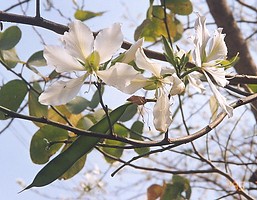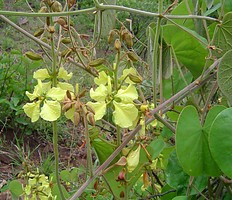Cercideae
Martin F. Wojciechowski and Johanna Mahn


This tree diagram shows the relationships between several groups of organisms.
The root of the current tree connects the organisms featured in this tree to their containing group and the rest of the Tree of Life. The basal branching point in the tree represents the ancestor of the other groups in the tree. This ancestor diversified over time into several descendent subgroups, which are represented as internal nodes and terminal taxa to the right.

You can click on the root to travel down the Tree of Life all the way to the root of all Life, and you can click on the names of descendent subgroups to travel up the Tree of Life all the way to individual species.
For more information on ToL tree formatting, please see Interpreting the Tree or Classification. To learn more about phylogenetic trees, please visit our Phylogenetic Biology pages.
close box
Introduction
Found across the globe from North America to East Asia, the tribe Cercideae is the basally branching lineage in Fabaceae. The tribe is divided into two subtribes, Cercidinae, the subtribe containing Cercis, Griffonia, and Adenolobus, and Bauhiniinae, the subtribe containing Bauhinia sens. lat. and Brenierea, based on seed, floral and fruit characters (Wunderlin et al., 1981, 1987).
Within Cercideae, Cercis L. ("redbud"), which is the sister group to the rest of the tribe, includes 10 species of shrubs and small trees found in Mediterranean climates from western North America to central Asia. Many of the species of Cercis have papilionoid-like flowers, but the genus is not closely related evolutionarily to Papilionoideae (Lewis and Forest, 2005). Cercis canadensis, found in the eastern United States, produces red-purple flowers that are edible and used in salads. Griffonia and Adenolobus are both African genera, with Griffonia found in Western Africa and Adenolobus found in Southwestern Africa (Mabberley, 1993). Adenolobus often have glandular fruits, the characteristic they get their name from, and grow in tropical to subtropical shrublands. Griffonia are shrubs and lianas found in tropical humid forests, swamp forests, thickets, and grasslands and are often used to make huts and baskets, and as medicines (Lewis and Forest, 2005).
According to Lewis and Forest (2005) Bauhinia sens. lat. is divided into eight genera of trees and shrubs found in pantropical regions. The number of genera in Bauhinia sens. lat. is still debated due to great diversity among the group. The eight genera included in Bauhinia sens. lat. are Bauhinia, Gigasiphon, Tylosema, Barklya, Lysiphyllum, Phanera, Lasiobema, and Piliostigma. Brenierea is a monotypic genus (one species) of tree or shrub found in Madagascar in subtropical scrubland (Lewis and Forest, 2005). Bauhinia is a pantropical genus of 150 to 160 species of trees and shrubs, although most abundant in the Neotropics (Lewis and Forest, 2005), and many species are lianas. The flowers of Bauhinia are often pollinated by bats, birds, or insects and some species produce explosive fruit, known to project seeds up to 15 m (Mabberley, 1993). Species of Bauhinia are used medicinally, for tanning, and as food, dyes, and timber (Mabberley, 1993). The other genera in Bauhinia sens. lat. include several species of lianas and species that are important economically for their uses as timber, medicinally, and sources of food.
Discussion of Phylogenetic Relationships
Tribe Cercideae forms the basally branching lineage within Fabaceae (i.e., the sister group to the rest of the family), a position supported by numerous studies (e.g., Bruneau et al., 2001; Kajita et al., 2001; Herendeen et al., 2003). In spite of considerable taxonomic work on the tribe in the last 30 years, few species have been included in phylogenetic analyses of either molecular or morphological data and thus inter- and intrageneric relationships remain largely unresolved (Bruneau et al., 2001; Herendeen et al., 2003). Within Cercideae, Cercis L. is the most basally branching genus in the tribe, and recent studies have provided some resolution of relationships in this genus (e.g., Davis et al., 2002). Cercis plus Adenolobus and Griffonia appear to form the sister group to Brenierea plus Bauhinia sens. lat., but this relationship has not been well supported (here shown as a polytomy). In addition, relationships among Lysiphyllum, Phanera, Lasiobema, and Piliostigma are poorly resolved, largely due to sparse sampling from these genera.
References
Bruneau, A., F. Forest, P. S. Herendeen, B. B. Klitgaard, and G. P. Lewis. 2001. Phylogenetic relationships in the Caesalpinioideae (Leguminosae) as inferred from chloroplast trnL intron sequences. Systematic Botany 26: 487-514.
Davis, C. C., P. W. Fritsch, J. Li, and M. J. Donoghue. 2002. Phylogeny and biogeography of Cercis (Fabaceae): evidence from nuclear ribosomal ITS and chloroplast ndhF sequence data. Systematic Botany 27: 289-302.
Herendeen, P. S., A. Bruneau, G.P. Lewis. 2003. Phylogenetic relationships in caesalpinioid legumes: a preliminary analysis based on morphological and molecular data. Pages 37-62 in Advances in Legume Systematics, part 10, higher level systematics (B.B. Klitgaard and A. Bruneau, eds.). Royal Botanic Gardens, Kew, UK.
Kajita, T., H. Ohashi, Y. Tateishi, C. D. Bailey, and J. J. Doyle. 2001. rbcL and legume phylogeny, with particular reference to Phaseoleae, Millettieae, and allies. Systematic Botany 26: 515-536.
Lewis, G. P. and F. Forest. 2005. Cercideae. Pages 57-67 in Legumes of the World (G. Lewis, B. Schrire, B. MacKinder, and M. Lock, eds.). Royal Botanical Gardens, Kew, UK.
Mabberley, D. J. 1993. The plant-book, a portable dictionary of the higher plants. Cambridge University Press. UK.
Wunderlin, R., K. Larsen, and S. S. Larsen. 1981. Cercideae. Pages 107-116 in Advances in legume systematics, part 1 (R. M. Polhill and P. H. Raven, eds.). Royal Botanic Gardens, Kew, UK.
Wunderlin, R., K. Larsen, and S. S. Larsen. 1987. Reorganizaztion of the Cercideae (Fabaceae: Caesalpinioideae). Biol. Skr. 28: 1-40.
Title Illustrations

| Scientific Name | Cercis chinensis Bunge |
|---|---|
| Specimen Condition | Live Specimen |
| Body Part | flower |
| Copyright | © Annette Hoeggemeier |
| Scientific Name | Bauhinia variegata L. (var. candida) |
|---|---|
| Specimen Condition | Live Specimen |
| Copyright | © L. Ramsden |
| Scientific Name | Tylosema fassoglensis (Kotschy) Torre & Hillc. |
|---|---|
| Location | Vumba rd near Altar Site, Mutare, Zimbabwe |
| Copyright | © 06/2006 Mark Hyde and Bart Wursten |
About This Page
Martin F. Wojciechowski

Arizona State University, Tempe, Arizona, USA
Correspondence regarding this page should be directed to Martin F. Wojciechowski at
mfwojciechowski@asu.edu
and Johanna Mahn at
johannamahn@gmail.com
Page copyright © 2006 Martin F. Wojciechowski and Johanna Mahn
All Rights Reserved.
- First online 14 June 2006
- Content changed 14 June 2006
Citing this page:
Wojciechowski, Martin F. and Johanna Mahn. 2006. Cercideae. Version 14 June 2006 (under construction). http://tolweb.org/Cercideae/60233/2006.06.14 in The Tree of Life Web Project, http://tolweb.org/









 Go to quick links
Go to quick search
Go to navigation for this section of the ToL site
Go to detailed links for the ToL site
Go to quick links
Go to quick search
Go to navigation for this section of the ToL site
Go to detailed links for the ToL site